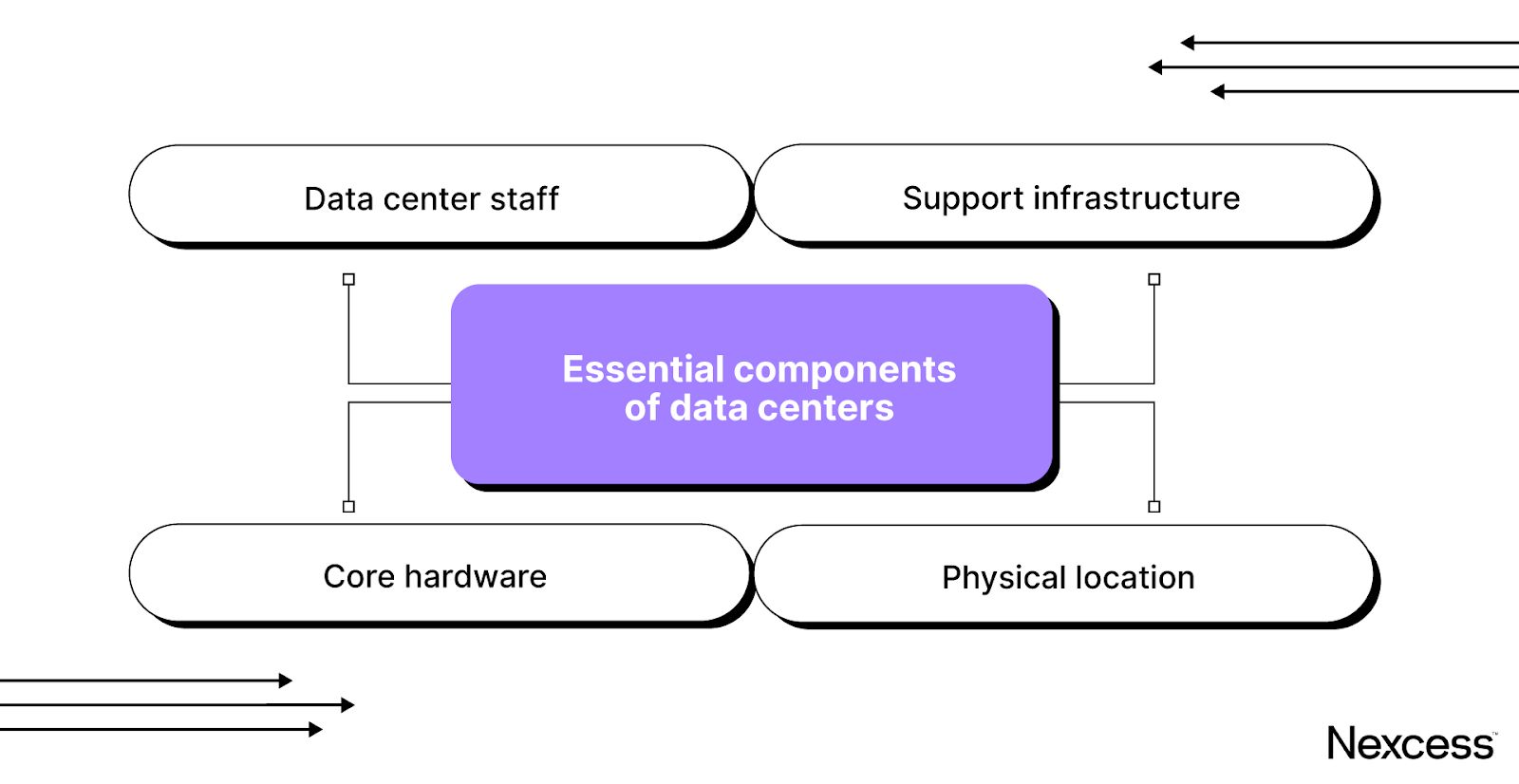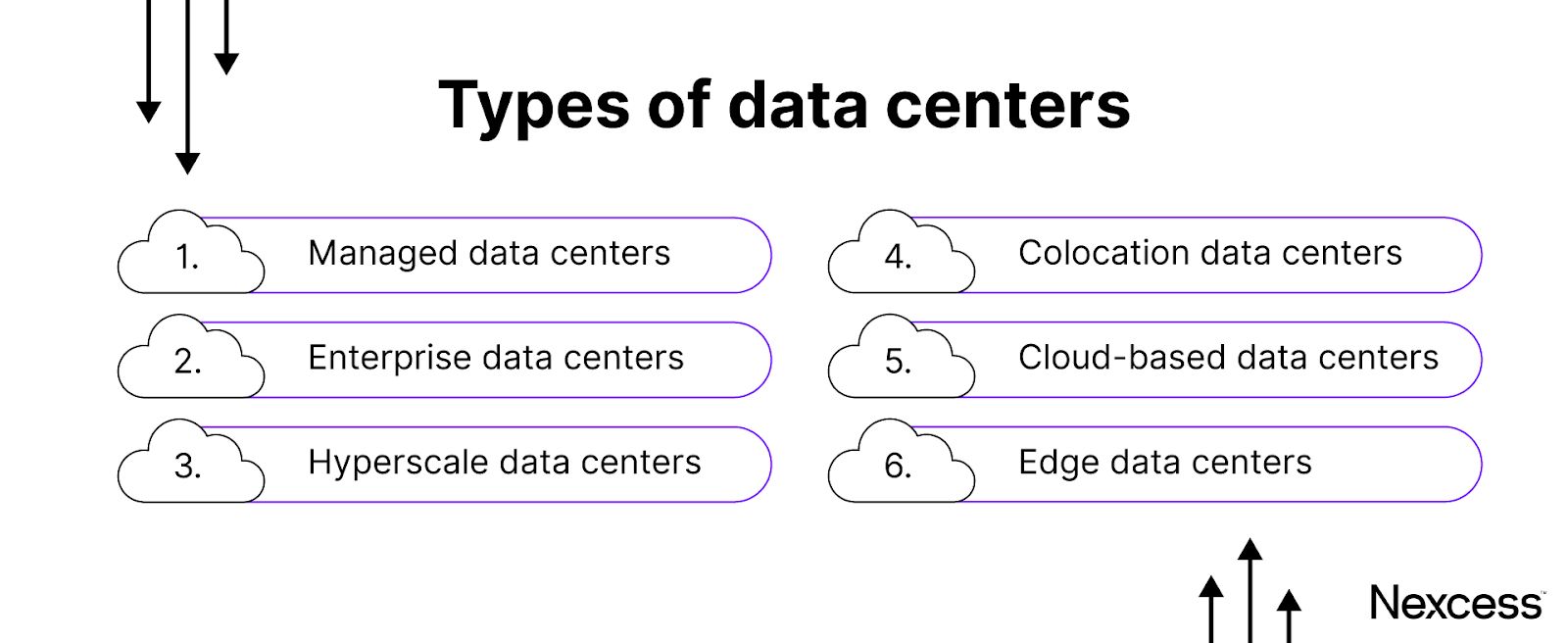Hosting your ecommerce website or business application with a hosting provider offers many benefits, including dedicated support, reliable uptime, and lowering expenses.
However, not all hosting options are equal. Your hosting experience may vary depending on the type of data center since the hosting infrastructure affects how your application performs or website loads.
To get the most out of your spending, you must opt for a hosting plan backed with a data center that ticks all your needs and requirements.
Read on to learn about what data centers are, how they work, and which type you need.
- Data center 101
- Benefits of data centers
- What are the essential components of data centers?
- Data center design standards
- Types of data centers
- Final thoughts: Beginner’s guide to data center types
Data center 101
A data center is a facility that hosts computer systems and their associated components to store, process, manage, and distribute large amounts of data. A standard data center comprises multiple networked computers, storage, computing infrastructure, and cooling systems.
Traditionally, physical data centers were an essential part of business infrastructure for large businesses that relied on heavy-duty computation, massive data storage, and similar technical requirements. However, they meant a significant amount of capital investment.
Nowadays, third-party data center providers facilitate everyone who requires a data center without a steep sticker price of an on-premises data center. For instance, you can buy a specific number of resources for a required time period instead of investing in a complete computing system.
Benefits of data centers
Modern data centers offer several benefits to businesses:
- Robust security: Data centers typically have an enterprise-grade security system. It ensures your critical business and customer information is safe from malicious agents.
- Resource optimization: With data centers, you delegate much of your IT-related workload to the hosting provider, including computational work and data storage. This saves you time and energy to allocate toward innovation and business growth.
- Cloud offerings: Data centers also help businesses offer cloud-oriented solutions. For instance, cloud computing allows businesses to offer SaaS-based solutions in the form of web apps and mobile apps. Similarly, the Internet of Things (IoT) also relies on data centers.
What are the essential components of data centers?

What goes into building a data center? That’s an important piece of information to consider when you’re looking into selecting a data center for your unique requirements.
To start, there’s no one-size-fits-all approach. Each data center has its unique architecture, depending on the use case. For instance, an offline data center for medical data storage might have different requirements than an online data center that processes ecommerce transactions.
Still, you can typically sort a data center’s specifications into four categories.
Physical location
A data center should have plenty of floor space to house servers, power suppliers, backups, and other equipment and infrastructure. Typically, you also want the data center facility to have security access controls restricting access to relevant people.
Besides that, the geographical location of the data center also matters. At the very least, you should try to consider:
- Security situation: You want the data center to be in a secure location since a physical data breach can result in customers losing trust in you. To ensure that, look for data centers in safe areas.
- Data-related laws: If you’re dealing with personal data, you’ll have to comply with data protection laws such as GDPR that restrict data transfer outside certain regions. Make sure the data center is located in a location that makes such compliance convenient for you.
- Network infrastructure: Data speeds and latency depend on the distance between the data center and the target audience. Ensure the data center's geographical location is close to the target audience to improve the user experience.
Data center staff
Data center staff includes employees who monitor, maintain, and manage the data center infrastructure 24/7. Typically, it includes security personnel, IT professionals, support agents, power engineers, and other relevant staff.

However, if you’re looking for a PCI-compliant data center, you should also ensure that the data center has compliance experts among its staff.
Core hardware
Core hardware refers to the servers, computers, and equipment necessary for IT operations and data storage. It includes networking equipment, processors, storage devices, and multiple security features, including enterprise-level firewalls.
Without these resources, a data center is incomplete since they make up the core of a data center.
Support infrastructure
Support infrastructure ensures that core components are operational at all times and conditions are set to maximize uptime.
Support infrastructure includes:
- Backup generators (in case of power failures).
- UPS systems.
- Electrical switches.
- Heating ventilation and air conditioning (HVAC) systems.
- Exhaust systems.
- Computer room air conditioners.
- Biometrics and surveillance systems.
Data center design standards

The Telecommunications Industry Association (TIA) has established the TIA-942 standard for data centers that covers critical aspects, including architecture, safety, physical security, redundancy, and environmental design.
TIA-942 shares the following four rating levels for data centers based on the data center infrastructure.
Tier 1 data center: Basic Site Infrastructure
Tier 1 data centers offer a basic level of support for IT systems, typically in an office setting. They come with an uninterruptible power supply for potential power outages and spikes, a dedicated physical area for IT systems, cooling equipment, and a backup power generator.
Tier 2 data center: Redundant Component Site Infrastructure
Tier 2 data centers come with extra cooling components like chillers, cooling units, and exhaust pumps. They typically offer better maintenance and protection against disruptions than tier 1 data centers, and you can replace components without shutting the system down.
Still, unexpected failures can impact the system. They can experience a downtime of up to 22 hours.
Tier 3 data center: Concurrently Maintainable Site Infrastructure
Tier 3 data centers offer high data redundancy levels and allow equipment maintenance or replacement without system shutdown. They have redundant support systems such as power and cooling units, ensuring a very low annual downtime of less than 1.6 hours.
Tier 4 data center: Fault Tolerant Site Infrastructure
Tier 4 data centers have physically isolated systems that prevent disruptions from planned and unplanned events. They are fault-tolerant, fully redundant, and can guarantee a downtime of only 26 minutes annually.
For example, Nexcess data centers with almost 100% uptime and less than 15 minutes of annual downtime are regarded as tier 4 data centers.
Types of data centers
Depending on the size and management of the data center, there are several types of data centers: managed data centers, enterprise data centers, hyperscale data centers, colocation data centers, cloud-based data centers, and edge data centers.

Managed data centers
A managed data center is a facility owned by a third-party business or company that leases the service to other users or businesses. These data center types often offer massive storage space and exceptional computing service.
Managed data centers are ideal for businesses looking to outsource their data storage and computing needs. They help companies optimize their business overheads by opting for affordable data center services without owning the infrastructure.
Enterprise data centers
Enterprise data centers are dedicated data centers a company itself owns to support its storage and computing needs. Since this setup is often expensive, only companies with unique data and network needs opt for enterprise data centers.
Most enterprise data centers are on-site, often within the same premises as the organization.
However, off-site enterprise data centers aren’t out of the question either. With an off-site data center, a company may get a data center with better security, connectivity, and power supply infrastructure.
A good use case of an off-site enterprise data center is to provide a backup in case a natural disaster takes the primary data center offline.
Hyperscale data centers
Hyperscale data centers are the largest data centers with extensive infrastructure support. These data centers support large-scale IT projects, like social media platforms and search engines.
Companies like Amazon, Google, and Microsoft run massive hyperscale data centers, specifically for big data storage and cloud computing.
Unlike traditional data centers that support tens of servers, hyperscale data centers can support several thousands of individual servers. For instance, a typical hyperscale data center can have about 5000 servers in less than 10,000 square feet.
Colocation data centers
Colocation or multi-tenant data centers serve businesses that want to host their servers off-site and away from their business premises. Colocation data centers are typically owned by service providers that provide power, security, cooling, and networking components.
A colocation data center can be ideal for:
- Saving resources: Instead of committing precious business resources to build a data center, you rent space on a colocation data center to run your servers.
- Outsourcing IT needs: You can use the IT team provided by the colocation data center service provider and save business resources for other functions.
- Easier scalability: You can lease as much space as you need to support your business's rapid expansion or contraction at a moment’s notice, with minimal operational losses.
Cloud-based data centers
Cloud data centers are distributed data centers run by third-party service providers. These data centers let you rent both space and infrastructure as needed via cloud services. You can typically provision virtual data centers within hours.
Cloud data centers are cost-efficient since they reduce costs surrounding hardware investment, IT staff, and maintenance. They also allow businesses to scale up or down at record speeds, share resources, and enjoy optimal uptime, bandwidth, and redundancy.
Edge data centers
Edge data centers, typically smaller than other data center types, help businesses facilitate data transfer requiring minimum delay. They are typically located near the end user.
Edge data centers are used to process data in real time for IoT, automation, and emergency applications, given their requirement for low-latency communications.
Final thoughts: Beginner’s guide to data center types
As our reliance on technology continues to grow, data centers will remain a vital component of our modern infrastructure, driving innovation, powering the digital economy, and shaping the future of our world.
If you’re looking for a service provider that covers all the basics and more, consider Nexcess. With Nexcess hosting plans, you can enjoy hosting support for your WordPress website, WooCommerce store, and more at our tier 4 data centers.
In addition, if you need a solution that fulfills your enterprise needs, you can opt for Nexcess enterprise hosting.
Check out our plans to get started with Nexcess today.
This blog was originally published in October 2018. It has since been updated for accuracy and comprehensiveness.

